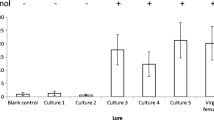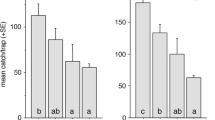Abstract
MALES of the grass grub beetle Costelytra zealandica (White) (Coleoptera : Scarabaeidae), the principal insect pest of pastures in New Zealand, are attracted to an adhesive preparation1 and to a resin2 both of which seem to contain a chemical sex attractant. These materials contain small amounts of free phenol, which has been shown to be attractive to male beetles and seems to be the only attractant present in the resin. Furthermore, phenol may be the natural attractant of C. zealandica3,4. Most studies of structures associated with the production of insect sex pheromones have been concerned with the Lepidoptera, and in spite of increasing interest in pheromones produced by the Coleoptera, little has been published. We have attempted to locate possible sites of pheromone production in the female grass grub beetle.
Similar content being viewed by others
References
Osborne, G. O., and Hoyt, C. P., Bull. Entomol. Res., 59, 81 (1969).
Osborne, G. O., and Hoyt, C. P., Ann. Ent. Soc. Amer., 63, 1145 (1970).
Henzell, R. F., NZ J. Agric. Res., 13, 294 (1970).
Henzell, R. F., and Lowe, M. D., Science, 168, 1005 (1970).
Osborne, G. O., and Hoyt, C. P., NZ J. Sci., 11, 137 (1968).
Author information
Authors and Affiliations
Rights and permissions
About this article
Cite this article
HOYT, C., OSBORNE, G. & MULCOCK, A. Production of an Insect Sex Attractant by Symbiotic Bacteria. Nature 230, 472–473 (1971). https://doi.org/10.1038/230472a0
Received:
Issue Date:
DOI: https://doi.org/10.1038/230472a0
- Springer Nature Limited
This article is cited by
-
Impact of intraspecific variation in insect microbiomes on host phenotype and evolution
The ISME Journal (2023)
-
Intestinal microbiota and functional characteristics of black soldier fly larvae (Hermetia illucens)
Annals of Microbiology (2021)
-
Identification and field verification of an aggregation pheromone from the white-spotted flower chafer, Protaetia brevitarsis Lewis (Coleoptera: Scarabaeidae)
Scientific Reports (2021)
-
Microbiota in insect fungal pathology
Applied Microbiology and Biotechnology (2018)
-
Host plants and obligate endosymbionts are not the sources for biosynthesis of the aphid alarm pheromone
Scientific Reports (2017)





